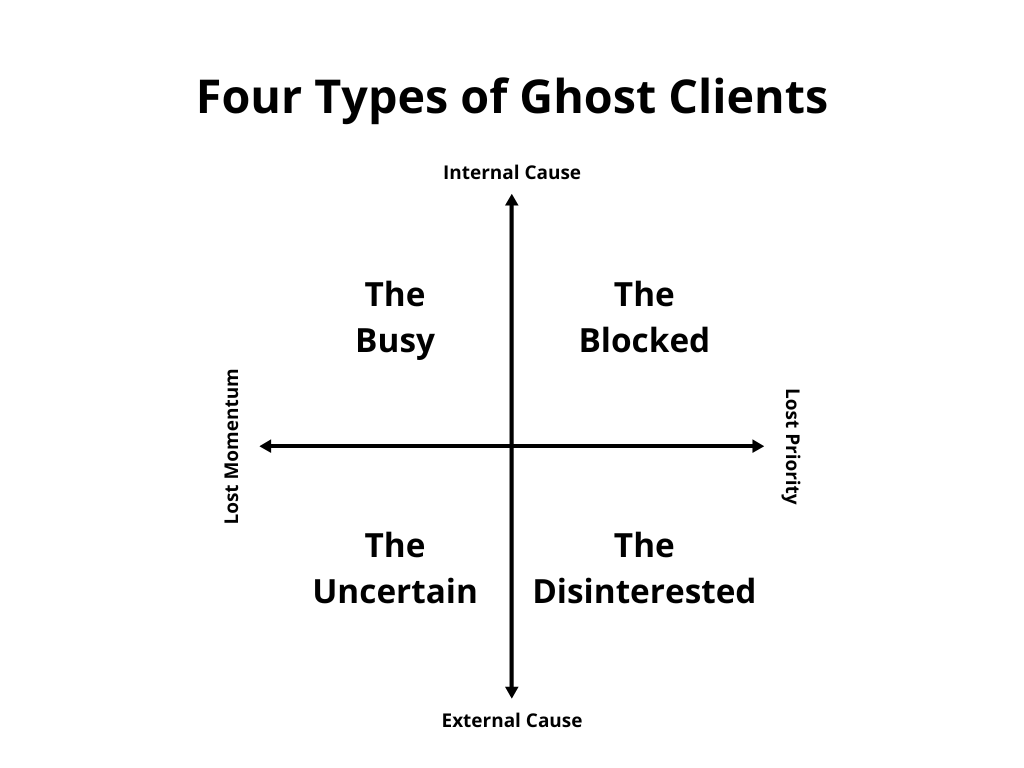- The 2x2
- Posts
- How to Bring Back Ghosts
How to Bring Back Ghosts
Welcome back to The 2x2 - the ultimate newsletter for executive consultants!
It’s halloween week, folks. 🎃
And in this one, we’re doing something spooky — summoning the phantom leads back to life. 🪦
Read on…
⏰ Today in 5 minutes or less:
Most leads ghost because of their own situation. Understanding the reason it easier to tailor a comeback for them.
Reminders are useful, but offering value gives people reason to re-engage. Offer something genuinely relevant or new to them on your next outreach.
If you keep getting ghosted on specific stages or offers, it’s a signal to revisit positioning.

Ghost Stories from the Inbox: How to Bring Prospects Back to Life
You know the feeling.
The proposal went out. The last call was great. You hit send and followed up many times.
And then, silence.
No “thanks, but not now.” No “we went another direction.”
It happens to every consultant, even seasoned ones.
But the good news? Ghosting rarely means a hard no.
More often, it means “not yet.” Sometimes, they’re stuck in internal chaos. Sometimes, the project slipped off their radar.
The trick isn’t to chase, but to reconnect under the right time and circumstances.
Here’s how to bring those deals back to life (and how to keep the next ones from vanishing).
Why Prospects Ghost
Before winning them back, it’s important to diagnose why they disappeared first.
Most prospects ghost because of their own situation – maybe they’re busy, distracted, or navigating through approval layers and office politics. Understanding the type of ghost makes it easier to tailor a comeback for them.
Here’s a simple way to think about the ghosts:

The Busy Ghost – These prospects liked the proposal, but got buried by other fires.
💬 Common response: “We just need to get through Q3 first...” but it never ends.
The Blocked Ghost – They probably had a change of priorities, which made your project no longer urgent.
💬 Common response: “We're waiting on leadership approval.”
The Uncertain Ghost – They weren’t fully convinced or didn’t know how to sell the pitch to the rest of the team.
💬 Common response: “Let me talk to the team first.”
The Disinterested Ghost – Those that quietly decide not to move forward.
💬 Common response: “We’ll circle back next year.”
Now, let’s summon back these ghosts without sounding desperate or robotic.
The Comeback Sequence
The key to a good comeback starts with empathy and ends with clarity. Instead of making it about the pipeline, make it about their problem and your support.
Here’s how that looks like in four steps:
Step 1: Reset the tone.
Always start with curiosity, not accountability. It will give them space to re-engage without guilt.
“Hey [Name], when we spoke last month, you mentioned [initiative]. Curious how that turned out – still a live topic or paused for a bit?”
Now, tailor it to the prospect:
For the busy – keep it short, maybe a two-sentence note or quick LinkedIn DM.
For the blocked – acknowledge the politics and show understanding.
For the uncertain – add reassurance and reiterate what they valued most.
For the disinterested – skip the small talk and gently test the waters.
Step 2: Offer fresh value, not a reminder.
Reminders are useful, but offering value gives them reason to re-engage. Offer something genuinely relevant or new:
“We just helped another client in [industry] streamline [relevant problem]. Thought you might find it interesting.”
And then for each prospect:
For the busy – a short two-line insight.
For the blocked – an ammo to re-sell the pitch internally.
For the uncertain – a story to rebuild confidence on the pitch.
For the disinterested – reframed benefits, focusing on outcomes.
Step 3: Make disengagement safe.
Sometimes, the easiest way to bring them back is to let them go.
“If priorities shifted, no problem at all – I can close the loop on my end and circle back later.”
This permission might get replies like, “Actually, we still need this – timing just got messy.”
Here’s how to adjust the tone depending on the prospect:
For the busy – empathetic and brief.
For the blocked – invite a light vent.
For the uncertain – reassure that re-engaging later is normal.
For the disinterested – leave the door cracked, but don’t push.
Step 4: If silence persists, change channels.
Aside from what you say, where you say it is also important.
It’s best for busy clients to engage publicly, to serve as a low-effort reminder that the pitch exists.
For blocked prospects, try to loop in a secondary contact. Dropping a short, no-pressure note is the key for uncertain clients.
Lastly, visibility should be the focus for disinterested prospects. Post about their challenge areas – and if it hits, they will reappear on their own.
How Vindali Vartak Came Back from a Rejection
Some no’s aren’t the end, but a pause before the right opportunity.
Vindali Vartak learned this early in her journey – when she seemed like a perfect fit in a company and knew she could make a difference.
Someone else got the role, but instead of closing the door, Vindali reached out to the CEO. She expressed how she saw a genuine need for her experience and skills, so they brought her in to work alongside the person they hired.
Her takeaway? Every no is either a redirection, lesson, or matter of timing.
Ghosting works in the same way: prospects don’t vanish for good; they resurface when timing, fit, or focus aligns.
Watch our full interview here:
Keeping the Next Ones from Vanishing
It’s hard to eliminate ghosting altogether, but consultants can make it rarer. The key is to redesign the rhythm, so it doesn’t depend on luck.
Some habits that might help:
End with the next step. Never close a call without a clear action. “I’ll follow up” isn’t a plan, but “Let’s touch base on the 18th” is.
Don’t rush the proposal. Ghosting starts with premature pitching. Before pulling up a slide deck, confirm urgency, budget readiness, and decision process first.
Leave value breadcrumbs. Keep sharing relevant ideas and articles even if they go quiet. Staying on top of mind will benefit you in the end.
Track ghosting patterns. If people start ghosting on specific stages or offers, it’s a signal to revisit positioning.
Talk to the Ghost in the Inbox
If there’s a ghost in the inbox, re-humanize it.
Sometimes, it’s the quiet prospects that turn into the best clients once timing, attention, or politics shift in your favor.
Keep your tone kind and stay visible. They always come back when you make it easy for them to find you.

This Could Have Been a Deck.
This reel is giving me PTSD.

Remember, the path to success is paved with continuous learning and embracing fresh perspectives.
Let's stay connected, share ideas, and elevate your consulting business.
Stay curious, friends.
The 2×2 is brought to you by Keenan Reid Strategies
Having trouble viewing this email? Check out this and past issues on our website.
Was this newsletter forwarded? Someone is looking out for you. You should definitely subscribe!


